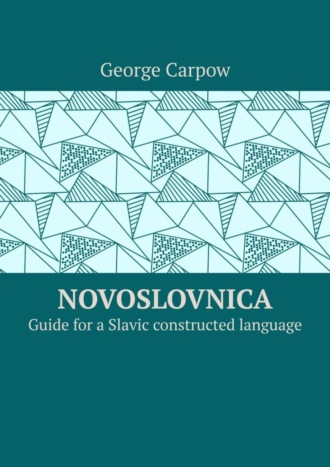
Полная версия
Novoslovnica. Guide for a Slavic constructed language

Novoslovnica
Guide for a Slavic constructed language
George Carpow
© George Carpow, 2019
ISBN 978-5-0050-5083-0
Created with Ridero smart publishing system
Acknowledgements
Starting this book I would like to appreciate some persons who had great influence on me writing this book. Such a work never can be done with efforts of a single man. I am grateful to those who believed in the project for the whole development period or just for a while.
First of all I want to thank Rafail Gasparyan. I suppose without his help and collaboration this book would have never been finished. And maybe so Novoslovnica would.
I would like to thank my Macedonian friend Kristijan Cvetanovski. His trust in Novoslovnica have been making me continue my work for all these five years. And with the help of him I discovered some important points that shook the grounds of the project a bit of times.
I want to thank my American friend Harris Mowbray and my Belarusian friend Sergey Yanchenko for editing English and Russian text of the work respectively.
Also I want to thank my Czech colleague Vojtěh Merunka for his critical view on this project. This made me rethink an amount of language details. Without that I don't believe Novoslovnica would have ever become a serious project.
I would like to thank my brother Ivan Carpow who spent his time and efforts on readting this book and making comments and corrections.
Moreover, I would like to appreciate persons that keep the inspiration inside me for these years: Manol Terziev (Bulgaria), Ivan Petrov (Bulgaria), Alexandra Getsich (Serbia), Ljiljana Bradich (Serbia), Igor Achkasov (Russia).
Foreword
Every language is alive – it is born, it grows up, it bares children and it dies.
The process of developing a language is unstoppable and it is cause by a lot of factors we cannot track.
What a beauty is a moment a new language appears. A lot of languages are old and appeared many years ago. However, there exist a very young ones were witnesses to be born i.e. Afrikaans (20 century), Yiddish (19 century) and extinct i.e. Prussian (18 century), Slovinian (20 century), Livonian (2013 year).
The language is naturally born doubly:
• by dialect divergence
• by two languages pidginating
The first way is much popular, though in pure form they both appear pretty rarely. This leads to differentiating of languages into a close language group.
Nevertheless, people sometime get into idea of reuniting these groups into a single language. This is not a natural way but we have examples of such a reunion. For example, modern German language was created from a group of different german languages and dialects to unite people into a single strong country. And they succeeded, so today we ahve a stable literary German language (though some region dialects still exist).
Moreover, people want to unite languages that have diverged much greater than German dialects did. It is rather enviable, though so many examples took place (Volapük, Novial). However, one of them, called Esperanto created by L.L. Zamenhof in 1887 year was very successful. Today more than 2 million people speak Esperanto and several thousand of them use it as a native language.
These examples show that the languages develop both ways – unification and divergence.
Novoslovnica as such a bridge for Slavic languages is working in direction of uniting the language. Collected expressiveness, beauty and purity of all Slavic languages, it tries to rework the idea of what a Slavic language should be.
It is not the only project in this sphere. Starting from Cyril and Methodius, Slavs continue to think about the idea of a common language when loosing the previous project in mind.
The need of a secular common language for Slavs is especially important since the twentieth century. The process of globalization is destroying weak languages and washing out a lot of root nests from others.
Novoslovnica in a row with other Slavic auxiliary language projects try to create something that Slavs could use to struggle the globalization process.
This book is for those who is interested in such an idea of a Slavic language reunion. Moreover, it reveals some historic features of our languages.
Hope you will enjoy reading this book and get something important for yourself when you finish it.
Novoslovnica is a standardized language project with strict rules in it that make the language able to be codified. Hope this will be useful for the interslavic community in developing the bridge between Slavic languages.
Whatever would be, anything you find useful in this book will make it worth writing, my dear reader.
You are welcome to write me all your wishes, comments and marks via email: support@novoslovnica.com
Best wishes,George CarpowBackground
It would be right if we start the book with the article 1that was the first on the way to Novoslovnica construction.
The Slavic world has a deep and rich history. The Slavic tribes appeared on the vastness of Europe, and during their history of growth and development they have reached an extraordinary territorial vastness of settlement. We can say that the formed tribes of the Slavs lived on a huge territory according to Europe standards: from the Elbe in the West to the Volga in the East, from the Aegean sea in the South to the Neva river in the North. Further, due to the development of Kievan Rus and the Russian state, the Slavs settled throughout Eastern Europe and Siberia. Despite all the contradictions in politics and strife, the cultural and linguistic component of the Slavs continued to be preserved. Of course, the tribes bordering on other Nations have experienced enormous cultural and linguistic pressure, including Turkic, Roman, Finno-Ugric peoples.
Despite this, the Slavs retained their cultural identity and mentality. So, we can easily understand a person from the same group (Eastern, Western, Southern) and with little difficulty can establish communication with a person from another group of Slavs. This gives us the right to talk about the brotherhood of the Slavic peoples.
Many of the Slavic peoples have sunk into Oblivion, some in very recent times. For example, the Polabian culture left with the language by the middle of the 20th century. However, most of them remained alive, and from our common efforts depends on what will be the future of the Slavs.
From modern Slavic peoples only East Slavic group had relative stability and self-sufficiency. Russian experienced several waves of foreign language intervention – Mongolian, German, French and English, from which he, generally speaking, came out the winner, in many cases enriching and diversifying its vocabulary. At the moment, the English intervention, the strongest since the Tatar-Mongolian yoke, which has withdrawn many native Russian words from our everyday life, has not ended. But Slavs do it, assimilating came, and sometimes returning lost.
The situation is different in other Slavic groups. Not possessing constant sovereign statehood, Western and Eastern Slavs were subject to constant influence other peoples. Thus, the intervention of Turkish language in the South Slavic languages and culture can be correlated with the Tatar-Mongolian yoke for Russia. After liberation from Turks, southern Slavs have become to experience Western influence, and we can to see enough a large number of borrowing from English, French and camping on p. in Bulgarian and Serbian languages.
Throughout its history, Western Slavs were constantly terrorized by the influence of Romanesque languages. So, under the onslaught of the Germans, the Slavs lost their land along the Elbe and retreated to the Oder. Thus, the influence of the Romanesque tribes was also facilitated by the adoption of the Latin alphabet by the languages of the Western Slavs, instead of a possible Glagolitic or Cyrillic. Anyway, Slavs, though, and have undergone numerous impacts on their culture, managed to keep a common language to the present day.
The problem of re-consolidation of the Slavic peoples worried all many centuries ago and attempts were made to implement it. This can be considered the creation of Kievan Rus, the Grand Duchy of Lithuania, the expansion of the Russian Empire to the West, the creation of friendly relations with the Balkans, the creation of the Grand Duchy of Lithuania, Yugoslavia, Czechoslovakia. However, the problem of the impossibility or short-lived nature of this Union arose not because of the establishment of friendly, fraternal relations, but the prevalence of the interests of one nation over all the other members of the Union, which inevitably led to the collapse and failure.
There is a fair idea that the inability to undertake such an Association is not only in the political interests of any country, Yes, undoubtedly, but also in the language of communication, state or Union language. It is impossible to make official all languages and adverbs existing in any district, and declaring one language more important than another we want this or not we turn ourselves to the further collapse of such relations.
The necessity and importance of the creation of the Slavic (pan-Slavic) language was realized in the 16th century, when the first attempts were made to create a common language for all Slavs. However, they did not bring the expected results and sank into oblivion.
Most recent developments of pan-Slavic languages are based on the principle of simplification, minimizing all vocabulary and grammar of languages. For example, these are Slovio and Medžuslovjansky. We believe this is fundamentally wrong, as the new language should not be aimed at the degradation of cultures, but rather to maintain the grandeur and beauty of Slavic culture and identity. Therefore, our principle is not to "Discard all that is foreign", but to "Unite all the best".
If we analyze why the Slavs need a new Slavic language, we can distinguish several positions:
• the need for an additional consolidating factor to unite the policy of the Slavic peoples.
• The need to strengthen mutual understanding and improve the Slavs ' perception of each other.
• Preserve the original richness and beauty of all Slavic languages.
• The impossibility of taking the role of the Slavic language of Russian (and Polish) due to historical reasons.
• Inability to accept the role of the Slavic language of the previous planned projects in full due to objective reasons.
Historical background
Baltic scientists in their research2 worked out a model of Slavic lexical identity. In the picture, you can see the percentage of common lexicon provided by connections between different Slavic languages.
There are three Slavic linguistic and ethnic branches – East Slavic (Russian, Belorussian, Ukrainian and Rusyn), West Slavic (Czech, Slovak, Polish, Kashubian, Silesian, Upper-Sorbian, Lower-Sorbian) and South Slavic (Slovenian, Serbian, Croatian, Macedonian and Bulgarian).
This division goes back into history. Different communication events with other nations, geographical position, territorial pecularity – everything affected Slavic people that became nations that now exist. It is supposed to have three initial tribes of Slavs: Venedes (the ancestors of West Slavs), Antes (the ancestors of East Slavs) and Sklavins (the ancestors of South Slavs). It is controversial, but a viable and a rather popular model within Slavic community.
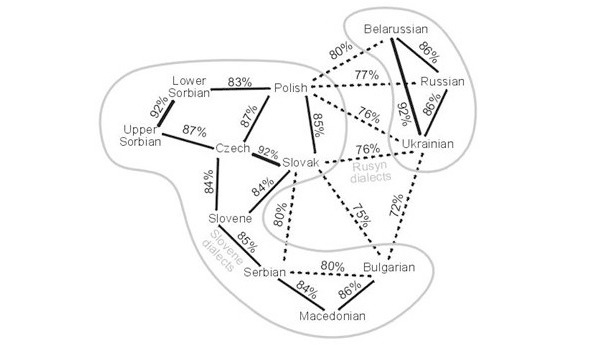
Lexicon connections in Slavic languages
Nevertheless, Slavs started to separate from each other in the seventh century. South Slavs came to Balkan peninsula and assimulated the Illyrian and Turkic peoples that lived there already. Thus, we see how Croatians and Bulgars appeared. The confrontation of Slavs and Germans lead to West Slavic peoples’ appearance. Spreading to the East and confrontation with Finno-Ugric and Turkic peoples poured out into the appearance of East Slavic nations.
Script background
One of the Central ideas of pan-Slavism is the creation of a common Slavic language. This problem was solved many times in one form or another and in different ways starting with the old Church Slavonic language created by St. brothers Constantine-Cyril and Methodius. The invention of the first common Slavic language is associated with the appearance of the first writing, which was to become common Slavic – Glagolitic.
However, over time, the part of the Slavs adopted the Cyrillic alphabet, the part took Latin, and some for a while had the Glagolitic alphabet, the Latin alphabet and a modified Cyrillic alphabet, known as bosancica or horvatica (there are other names). Glagolitic also changed, becoming from rounded "Bulgarian" an angular "Croatian". But the main thing was – the language itself changed. Once a common old Church Slavonic began to divide into version that started to converge with the live Slavic languages. We can name some versions of Church Slavonic: Russian Slavonic, Bulgarian Slavonic, Serbian Slavonic, Croatian Slavonic etc.
Attempts to solve the problem of separation of Slavic languages and scripts gave several options:
• To revive the Church Slavonic language anyhow with adding elements of live languages to it or without adding.
• Take one of the live languages, but with certain modifications – adding new letters or words from other Slavic languages, new grammatical structures and so on.
• As in the previous item, but do not change anything and try to spread the live language through educational courses and other forms of education.
• As in the previous point, but forcibly.
• Create a new artificial / semi-artificial language based on those elements of the Slavic languages that remain common or can be relatively easily reduced to common + a number of different elements, to facilitate the «entry» into the language of the Slavs who speak different Slavic languages, or on the basis of only common elements.
The second part of the problem is writing. Due to the fact that the Glagolitic alphabet and bosancica virtually disappeared and remained only in limited use (bosancica disappeared almost completely, and the Glagolitic alphabet is supported in Croatia), the remaining candidates for the Slavic alphabet stays Cyrillic and Latin.
Generally, it can be said that new interslavic projects often use the Latin alphabet that cuts obsessiveness of these projects, because Cyrillic and Latin alphabets still are native to Slavic writing systems:
• in one case, a literature began almost immediately with the Latin alphabet
• in the other a literature started with the Cyrillic alphabet
• somewhere both Latin and Cyrillic scripts are used
• somewhere the transition from Cyrillic to Latin script took place
In Yugoslavia, Cyrillic and Latin tried to lead to a common denominator through the creation of the so-called Slavica. The essence of Slavica was to leave the backbone of the Latin alphabet (all the basic letters + letters, the same for the Latin and Cyrillic), replace all the digraphs, letters with diacritics and digraphs with diacritics corresponding Cyrillic letters. In Yugoslavia, this was all the easier to do because the Yugoslav Cyrillic and Latin alphabet are completely identical in composition having a mutual transliteration of each other. However, this project failed because of the resistance of nationalists in Croatia.
Interslavic background
We all know that the idea of a common language for the Slavs hovers among the Slavic peoples for more than a Millennium. The first and only successful project to date was the Church Slavonic language of Cyril and Methodius. This language has successfully found its niche in religious use and is used with some changes to the present day. However, such attempts for the secular language were resumed only in the 17th century in the works3.4 Moreover, the working project was neither created nor introduced into society, while some similar projects of planned languages for romance languages have successfully taken root and found a wide response in society (Esperanto, Interlingua).
The revival of the idea of the inter-Slavic language in our days occurred in 1999, when mark Gucco from Slovakia created the language of Slovio. This language has a huge number of shortcomings and is currently not recognized as capable by any of the developers of the inter-Slavic project, but it served as a catalyst for the emergence of a large number of such projects and the development of the idea of creating a planned inter-Slavic language that could meet the needs of modern society.
After that, more than 20 similar projects, more or less developed, appeared in 10 years. In 2006 there was a project slavianski, created (Ondrej Rečnik and Gabriel Svoboda). This language was developed in parallel in different degrees of detail, he put his ideas Jan van Steenbergen and Igor Polyakov. In 2009, the project broke away from the project Slovioski (Steeven Radzikowski, Andrej Moraczewski and Michal Borovička), which tried to unite the ideas of Slovio and Slovyanski. However, in 2010, all these projects were merged into one under the name Interslavic (see below – Interslavic-2).
At the same time, the Czech programmer Vojtěch Merunka published under the name of Neoslavonic. This project suggested the idea of how the Church Slavonic language could develop in free development. In 2011, these two projects began cooperative work on a common case. (see figure 1) then, this project has taken a leadership position on the issue of building medullablastoma language. Only in 2012 there was one project of “Northern Slavic language” (Venedčyna), presented by Nikolai Kuznetsov, who then joined Interslavic, and in 2014 there was a project of Novoslovnitsa, presented by George Carpow and the development team mainly from the countries of Eastern and southern Slavs, which at the moment remains the only living independent project outside the project Interslavic.
Interslavic introduced the idea of flavorisation, which resulted in a valid language differentiation of dialects and spellings and the lack of codification. In 2017, the project Neoslavonic and Interslavic merged into a new project called interslavic-2, which was a compromise between the ideas of Vojtěch Merunka and Jan van Steenbergen (who headed the project interslavic-1). They presented their new ideas in the article5, which was published in July 2017.
Comparison with other projects
We can provide a little concept comparison of other interslavic projects: Neoslavonic6 and Interslavic7.
These projects had been developed before Novoslovnica appeared. Each of the projects has its own flavor or aim:
• Neoslavonic represents the idea of the possible development of Old Church Slavonic up to nowadays.
• Interslavic-1 develops the idea of finding a common core of modern Slavic languages and take features and lexicon that is common to all modern Slavic languages
• Novoslovnica from this point of view develops the idea of creating the language that unites most grammar features assimilated by different Slavic languages along with etymologically developed lexicon with regard to modern days.
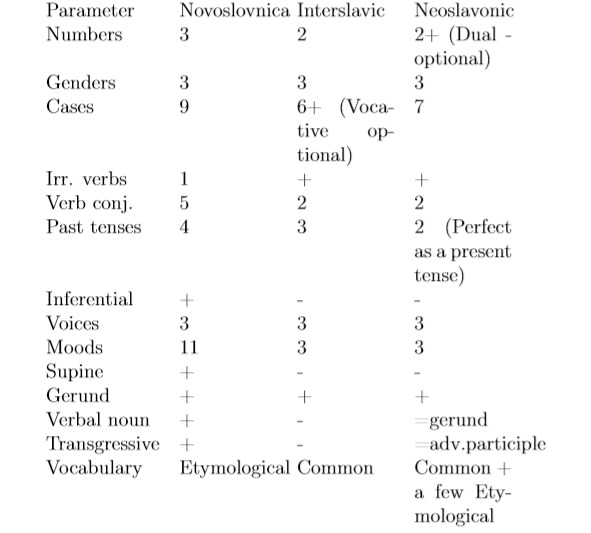
Short comparison of Novoslovnica with other projects
Phonology
Phonology – a branch of linguistics concerned with the systematic organization of sounds in the language. Phonology describes all the sounds that the language possesses.
Sounds can be divided into different classes. One of the characteristics for separating different sounds is the ability to pronounce them with an open vocal tract. You can notice that vowels (such as a, o, u in English) are able to be pronounced with open vocal tract, whereas consonants are pronounced with partly or completely closed vocal tract.
Moreover the term of allophone should be concerned before going further.
Allophone – one of a set of multiple possible spoken sounds or signs used to pronounce a single phoneme in a particular language.
This leads to the definition of a phoneme:
A phoneme is one of the units of sound that distinguish one word from another in a particular language.
Therefore, an allophone is such a sound (or a set of sounds) that does not influence the meaning of the word.
Vowels
In the beginning of this paragraph the description of a vowel should be given.
A vowel (V) – a sound produced with no constriction in the vocal tract.
With this information we can distinguish different types of vowels. The classification of vowels is based on two main factors:
• What is the row of the sound
• What is the height of the sound
• Whether the vowel is rounded or not
The row is the position of the tongue when you pronounce a vowel. There are three main rows: front, central and back. When you pronounce a vowel at the front row, you move your tongue toward the teeth. The descriptions of central and back rows are similar – you move your tongue to the center or toward the larynx to pronounce them.
The height of the sound is a characteristic of tongue convexity and tension in your mouth. If it is positive, it means your tongue does not touches the palate nor bottom of the mouth, and the tip of your tongue is tense- or closed. If your tongue is flat and parallel to the bottom of your oral cavity, moreover, it lies on it – it is an open one. Between these two positions a middle position can be found.
The roundedness of the vowel is the amount of rounding in the lips during the articulation of a vowel. Vowels can be categorized as rounded and unrounded. Thus, to pronounce a rounded vowel you should round your lips. To pronounce an unrounded vowel, you should relax your lips during the articulation of a vowel.
Finally, we can talk about Novoslovnica phonology. Novo-slovnica consists of 20 ordinary vowel phonemes. Among them there are seven closed vowels, three open vowels, ten middle vowels as well as seven front vowels, five center vowels and eight back vowels. On the table 1.1 you can see a chart position of the vowels in Novoslovnica.
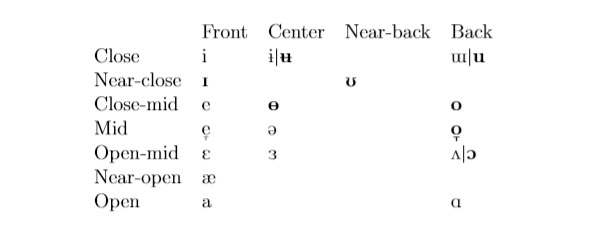
Vowels in Novoslovnica
In this table you can also see different vowels are font-styled differently. The bold ones are for rounded vowels. The normal ones are for unrounded vowels.
If you know Czech or Finnish, you might be concerned by the absence long vowels in this chart. It’s time to speak about allophones in Novoslovnica.
Novoslovnica has allophones of open and long vowels. This means that it does not matter how you pronounce a «modified» vowel – as a long one or as an open one – the meaning of the word will not change. To make this more clear, look at table 1.2.
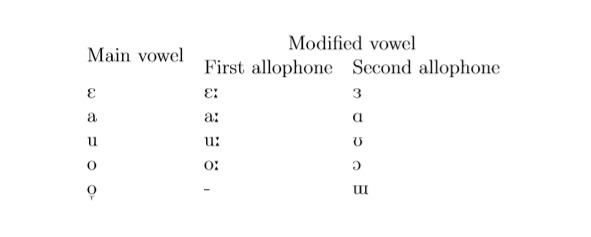
Long-vowel allophones in Novoslovnica
Exception:
o̞ (only one modified vowel – ɯ)
Examples:
Buda [`buda] (Buddha)
búda [`bu: da] (building) – [`bʊda]
If you have some knowledge about Slavic languages and their origins, you should know that the Proto-Slavic language had nasal vowels, which we can nowadays be found in Polish and Lithuanian. Do they exist in Novoslovnica? Of course they do! There are two allophones for pronouncing nasal vowels. The first one is actually a nasal vowel, when you pronounce an ordinary vowel through your nose. The second is more common, such as in French, when you add a nasal consonant [ŋ] to an ordinary vowel. Look at the sounds on the next table.
Examples:
Dųb (oak) [dõb] – [duŋb]
Męso (meet) [`mɛ̃so] – [`meŋso]
As you can see, Novoslovnica distinguishes between nasal vowels in two categories – O-nasality (hard) and E-nasality (soft).

